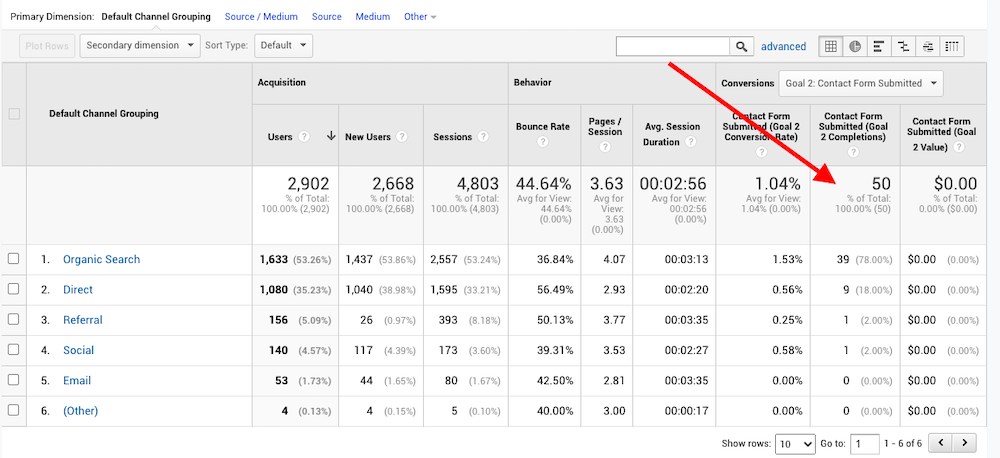What is a Conversion?
In marketing, a conversion in its simplest form is when a user performs a desired action. Think about the types of actions you might want your website visitors to take, like watching a video, filling out a form, or clicking a link to get directions. Each of those activities can be tracked as a conversion. But, why should a business owner pay attention to how visitors engage with their website?
Benefits of Conversion Tracking
Conversion tracking helps businesses to better understand the value of their website and online marketing campaigns. An e-commerce website could track how many products they’re selling, and the marketing channel that brought each customer to the website. A B2B SaaS company could track how many visitors request a product demo through their website, and which ad campaign brought them in the door.
When businesses track website conversions, they get a much better understanding of where customers are coming from, how customers respond to marketing, and where the sales funnel can be improved. Tracking conversions on your website will help you to:
- Understand how visitors engage with your site
- Make effective decisions about updating or changing your website
- Learn which marketing channels drive user engagement
- Measure SEO results
- Reduce customer acquisition costs
- Track ROI to more efficiently spend your PPC ad campaign budget
How to Choose the Right Conversions
What are visitors doing while on your website? More importantly, what do you want them to do? The list of actions that you could track as a conversion may seem endless. Choose meaningful actions that tell you something about a visitor’s intent.
What do you want the visitor to do?
Request a quote or a demo
Download an informational PDF
Call to schedule an appointment
Purchase a product
What action will the visitor take?
Fill out a form
Click a link
Dial your phone number
Submit an order
The Value of Conversions
Not all conversions are created equal. The actions visitors take on a website will have a different value depending on your business’s goals. There are three ways a conversion’s “value” can be measured:
- Monetary conversion: the conversion equates to a specific dollar amount; i.e. the revenue received by the business when visitors purchase a product on an ecommerce site.
- Primary conversion: the conversion equates to a lead generated by the website. The sales team will follow up on this lead and could convert it to a revenue-generating sale later. These leads may have a monetary value that this potential customer represents to the business.
- Micro conversion: the conversion shows user interest. For example, visitors may download a PDF to learn more about a service. These visitors could be targeted with a remarketing ad campaign to capitalize on their interest and bring them back to the website.
Useful Conversion Tracking Tools
Once you choose the actions you want to track, then it’s time to get technical. Unless you have some experience working on your website’s backend, setting up conversion tracking typically requires the assistance of a website developer or experienced digital marketing team. Don’t be afraid to ask for help!
Google Analytics
Google Analytics is the number one tool for tracking visits to your website because it allows you to connect the dots in your data. Once you set up Goals, which is just another name for conversions, you can see more details about the visitors who are engaging with your website. For example, say you create a goal that tracks how many visitors reach your “thank-you” page after filling out your contact form. In Google Analytics, you can analyze how many of those visitors came to your website from an organic search, or a social network like Facebook. You can even see more granular details like the user’s location when they visited your website. This is invaluable information that can help you do everything from improving your ad campaign targeting to measuring the ROI of your SEO efforts.
Tip: Setting up Goals in Google Analytics will let you track actions that future visitors take on your website, but cannot tell you about any actions that visitors took before you set the goals up. So start tracking your goals/conversions ASAP!
Google Tag Manager
Conversion tracking typically requires adding code to your website. With Google Tag Manager, code only has to be added to your website once. This makes life much easier for your website developer or digital marketing team. Once you have Google Tag Manager in place, you can use the platform to track numerous types of actions that your visitors take, such as:
- Clicks on links
- Clicks on website elements, like buttons
- Form submissions
- Video views
Google Tag Manager can send the data directly to Google Analytics, where you then create Goals and analyze your conversions.
Third-Party Tracking Tools
There are many third-party tools available that will help you track visitor engagement on your website. Call tracking platforms like CallRail allow you to track visitors who call your business after visiting your website. You can find out if those callers reached out after finding you through an organic search or PPC ad, for example. For more in-depth data, a conversion tracking tool like Jess will allow you to calculate exactly how much you are spending per lead that comes through your website.
Tip: When evaluating third-party tools, look for ones that push events to Google Analytics. Then you can track conversions both within the tool’s reporting platform as well as within your Google Analytics data.
The End Result
Setting up conversion tracking takes time, but the payoff is great. Once you begin tracking conversions, you’ll have a rich pool of data to work with. You can develop a conversion rate optimization strategy to make sure your website provides the best possible opportunities for visitor engagement and customer acquisition.
Whether you are coordinating your own campaigns or working with a digital marketing agency like Results Repeat, being clear about your goals and tracking conversions will ultimately improve your ROI and set your business on the path to success online.






